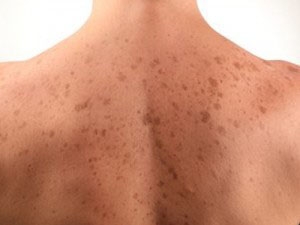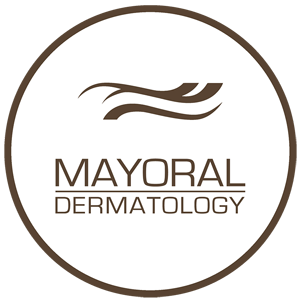
More About Age Spots
Medically referred to as “solar lentigo”, age or liver spots are areas where the acceleration of melanin production has created a concentrated “clump”of darker colored skin. Melanin is the substance produced by specialized epidermal cells that give us our skin color and protects our skin from the sun’s radiation. This is why your skin tans when exposed to sunlight and why people living in areas of intense, year around sunlight have darker skin than people living in less warm, cloudier regions.
People who use sun lamps or tanning beds may suffer more from age spots than those who spend time in the sun because of the closeness and intensity of the UV light emanating from the bulbs. In addition, some research suggests that the risk of developing cancer may be higher if you regularly use tanning beds, especially if you are genetically prone to skin cancer or have fair skin.
Although age spots are frequently called liver spots, their emergence has nothing to do with the liver or its functioning. When the color of the liver became known years ago, people just began calling solar lentigo spots “liver” spots because they did not know what caused them and thought the similar color might have something to do with the liver.
Age Spots versus Melanoma
Brown spots on skin are more likely to appear as we age because the skin becomes thinner and more transparent. Melanin clumps lying just below the surface of the skin are more easily seen when the skin loses its elasticity and density. You will recognize an age spot by its flatness and dark brown to light brown coloring. Small age spots resemble freckles while larger ones may look like brown, non-protruding, asymmetrical moles. Age spots do not change their appearance nor do they itch, bleed or crust over like precancerous growths.
If you can feel an age spot by running your finger over the area because it is protruding, it may not be an age spot. Suspected age spots that begin to grow, change color, bleed, become sore and protrude from the surface of the skin should be checked by a physician as soon as possible. Additionally, age spots may fade during winter when they are not exposed to sunlight. Precancerous and cancerous growths do not fade.
Popular Brown Spot Treatments
Mayoral Dermatology provides permanent, safe removal of age spots with a variety modern treatments that do not involve surgery, anesthesia or uncomfortable pain levels.
Among the more popular treatments performed at Mayoral Dermatology:
Intense Pulsed Light (IPL) phototherapy that targets age spots with an intense light beam that damages melanocytes responsible for brown spots on skin. As the skin immediately begins to repair itself, new cells are formed that do not contain heavy amounts of melanin. Consequently, age spots disappear and the skin is left looking smoother, refreshed and toned.
DermaSweep™ Microdermabrasion exfoliates the skin by using a wand tip that provides vacuum action to gently remove the skin’s uppermost layer. This vacuum action also cleans pores, increases blood flow to the area and eliminates unhealthy skin debris utilizing a HEPA filter. In addition to reducing the appearance of unsightly age spots, the DermaSweep™ Microdermabrasion system stimulates collagen production that promotes epidermis firming and toning. Other uses for this versatile skin-reconditioning technique include diminishing surgical scars, smoothing wrinkles and correcting uneven skin texture.
Glycolic acid peels are another one of Mayoral Dermtology’s treatments for removing age spots that does not cause patients to experience downtime. Made from sugar cane, our glycolic acid peel is simply a grade of AHA, or alpha hydroxy acid, that contains higher amounts of glycolic acid than over the counter products contain. Similar to exfoliation, acid peels remove dead skin cells to reveal a fresh layer of skin. Acid peels are also used to treat acne and diminish acne scars.
Give your skin a new life and look by visiting our providers at Mayoral Dermatology who specialize in removing age spots using any one of the treatment methods previously described. They can advise you which treatment would work best for your skin type and answer any other questions you may have about removing brown spots on skin.

